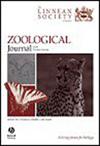Is Dorcadionini monophyletic? First phylogeny of the genus Eodorcadion reveals startling relationships in Central Asian flightless lamiines (Coleoptera: Cerambycidae)
IF 2.8
2区 生物学
Q1 ZOOLOGY
引用次数: 0
Abstract
The flightless tribe Dorcadionini is one of the most species-rich and taxonomically challenging groups in the family Cerambycidae. Eodorcadion is one of five genera included in Dorcadionini, and one of three distributed in Central Asia. The current classification of the genus is based on taxonomic works pre-dating the application of cladistic methods. We used molecular data from one mitochondrial and three nuclear markers (COI, CAD, ITS2, and Histone 3) for 70 specimens in 23 species and subspecies, representing all subgenera and most species groups of Eodorcadion to build its first phylogeny. By including some taxa of Central Asian Dorcadion and Lamia textor (type genus of Lamiini and Lamiinae), we assessed the monophyly of the tribe. The results of our analyses are the first to fully support the synonymy of Dorcadionini with Lamiini and confirm the morphology-inferred monophyly of Eodorcadion. Consequently, Lamiini = Dorcadionini syn. nov. Moreover, based on the obtained phylogeny and morphological differences, we diagnosed and subsequently described two new subgenera of Eodorcadion: Altaidorcadion Karpiński subgen. nov. and Arenodorcadion Karpiński subgen. nov., while the currently recognized subgenus Humerodorcadion stat. nov. was elevated to the genus rank. Our phylogeny is remarkably consistent with results previously obtained by other authors that used endophallic morphology.Dorcadionini是单系的吗?首次系统发育揭示了中亚无飞行动物群的惊人关系(鞘翅目:天牛科)
无飞行的Dorcadionini是天牛科中物种最丰富、分类最具挑战性的类群之一。赤藓属是赤藓属的五个属之一,也是分布在中亚的三个属之一。目前对该属的分类是基于在枝分类方法应用之前的分类学工作。我们利用Eodorcadion所有亚属和大多数种群的23个种和亚种的70个标本的一个线粒体和三个核标记(COI、CAD、ITS2和组蛋白3)的分子数据,构建了Eodorcadion的第一个系统发育。通过纳入中亚多卡迪亚群和拉米亚群(拉米亚群和拉米亚群的模式属)的分类群,对该部落的单系性进行了评价。我们的分析结果首次完全支持Dorcadionini与Lamiini的同义性,并证实了形态学推断的Eodorcadion的单系性。此外,基于所获得的系统发育和形态差异,我们诊断并随后描述了两个新的Eodorcadion亚属:Altaidorcadion Karpiński亚属。11 .和Arenodorcadion Karpiński亚群。而目前公认的Humerodorcadion stat. nov.则被提升到属级。我们的系统发育与其他作者先前使用内皮形态学获得的结果非常一致。
本文章由计算机程序翻译,如有差异,请以英文原文为准。
求助全文
约1分钟内获得全文
求助全文
来源期刊
CiteScore
6.50
自引率
10.70%
发文量
116
审稿时长
6-12 weeks
期刊介绍:
The Zoological Journal of the Linnean Society publishes papers on systematic and evolutionary zoology and comparative, functional and other studies where relevant to these areas. Studies of extinct as well as living animals are included. Reviews are also published; these may be invited by the Editorial Board, but uninvited reviews may also be considered. The Zoological Journal also has a wide circulation amongst zoologists and although narrowly specialized papers are not excluded, potential authors should bear that readership in mind.

 求助内容:
求助内容: 应助结果提醒方式:
应助结果提醒方式:


